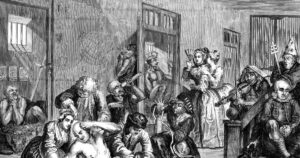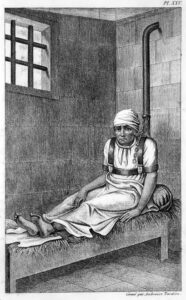
According to the Oxford dictionary, Bedlam means “ a scene of uproar and confusion”.
Interestingly, this is a word that has its origins in the history of psychiatric illness!
In the 12th century, Simon Fitzmary, a philanthropist, donated a piece of land to the religious order of the Priory of The Lady of Bethlem, in Bishopsgate, just outside of the Wall of London. The building housed a center which collected alms to support the crusader church. Over time, it morphed into a supervised housing for the poor, needy and finally the insane. By the 1300s it almost exclusively admitted mentally ill patients. For most of its history, Bethlem was one of the only dedicated mental health institutes in Britain.
Unfortunately, this was no cause for celebration.
During that period in time, mental ill health was mostly ascribed to possession by spirits, witches or an imbalance of humors within the body. Doctors only had a vague idea of the different types of mental illnesses that existed and that each of them required a different type of treatment. Most patients with abnormal behaviour were hence locked up, chained to beds and chairs in cramped quarters with no concern for their physical health or bodily needs.
The treatment procedures would include practices which seemed logical and practical at that time, but in reality seem extremely inhumane.
Some of the weird treatment protocols for the inmates included:
- Rotational therapy, proposed by none other than Erasmus Darwin, the grandfather of Charles Darwin, where patients were strapped to chairs and suspended mid air by a beam of ropes. The chair would then be rotated twenty to forty times in one direction and allowed to spin back! The recommended practice was to do this for an hour or two about three to four times a day for a month, to cure insanity!
- Cold water therapy, where patients were submerged in ice cold water for long durations or splashed with it, so that it would shock them out of their melancholic spells!
- Bleeding, purging and inducing diarrhea in an effort to balance the humors in the body.
- Providing bland non nutritious diet and starving to reduce the abnormal behavior.

Patients chained to their beds
Most patients admitted to the center suffered from severe mental illnesses and displayed abnormal, aggressive or apathetic behavior. Hence, they were confined to small cramped cells with an opening which served as a window. Patients rarely had access to toilets and had no proper clothes. Over time, the asylum turned into a shabby, poorly maintained, unhygienic fetid smelling but extremely noisy space.
Due to an increase in the number of inmates, Bethlem was shifted to a bigger premise in 1647. But though the new building was bigger, airer and spacious with large well maintained sprawling gardens, the care inside remained as appaling as before.
Eighteenth century medicine felt that madness robbed an individual of shame, emotion and reason to the extent that any form of humiliation or abuse would have no effect on them. Therefore, Bethlem, in an effort to support its deficit finances, opened its doors to visitors and tourists, who could, by paying a paltry sum of a penny, wander around the halls of Bethlem and “enjoy” the weird behavior of its inmates.
The visitors were allowed to taunt, jeer at, spit on or throw things at the chained patients so as to elicit a response out of them. This became such a popular form of entertainment for Londoners that, come Easter and Christmas, Bethlem would be flooded with people who would make noise and inturn agitate the inmates into creating a cacophony and chaos.
An account of diarist Ned Ward quotes that “We would hear such a rattling of chains, drumming of doors, ranting, hollering, singing and rattling where I could think of nothing but ….where the damn’d broke loose and put hell in an uproar”.
It became popular language to call difficult and severely ill psychiatric patients as “stark Bethlem mad” . Slowly the word Bethlem in popular culture came to mean chaos, confusion and noise and then morphed into a similar sounding “Bedlam”.
At the dawn of the nineteenth century, Bethlem became steeped in controversy due to its mismanaged finances, inhuman ways of treating its inmates and poor leadership. It hardly provided any prospect of cure for those in need, instead making their condition worse, A better understanding of mental illnesses and mental health reforms gradually paved the way for a positive change in the hospital. It was finally absorbed into the National health Services (NHS).

The hospital now
The hospital now includes specialized services in psychiatry alongside housing a “Bethlem Museum of the Mind” which features its infamous history and the evolution of the word bedlam.





Thanks for making efforts to write about these pieces from history. It’s always good to read up history lest we repeat same mistakes. Kindly continue the series on further modifications in treatment and beliefs
It’s very surprising as well as shocking! A great piece of writing. Thank you !